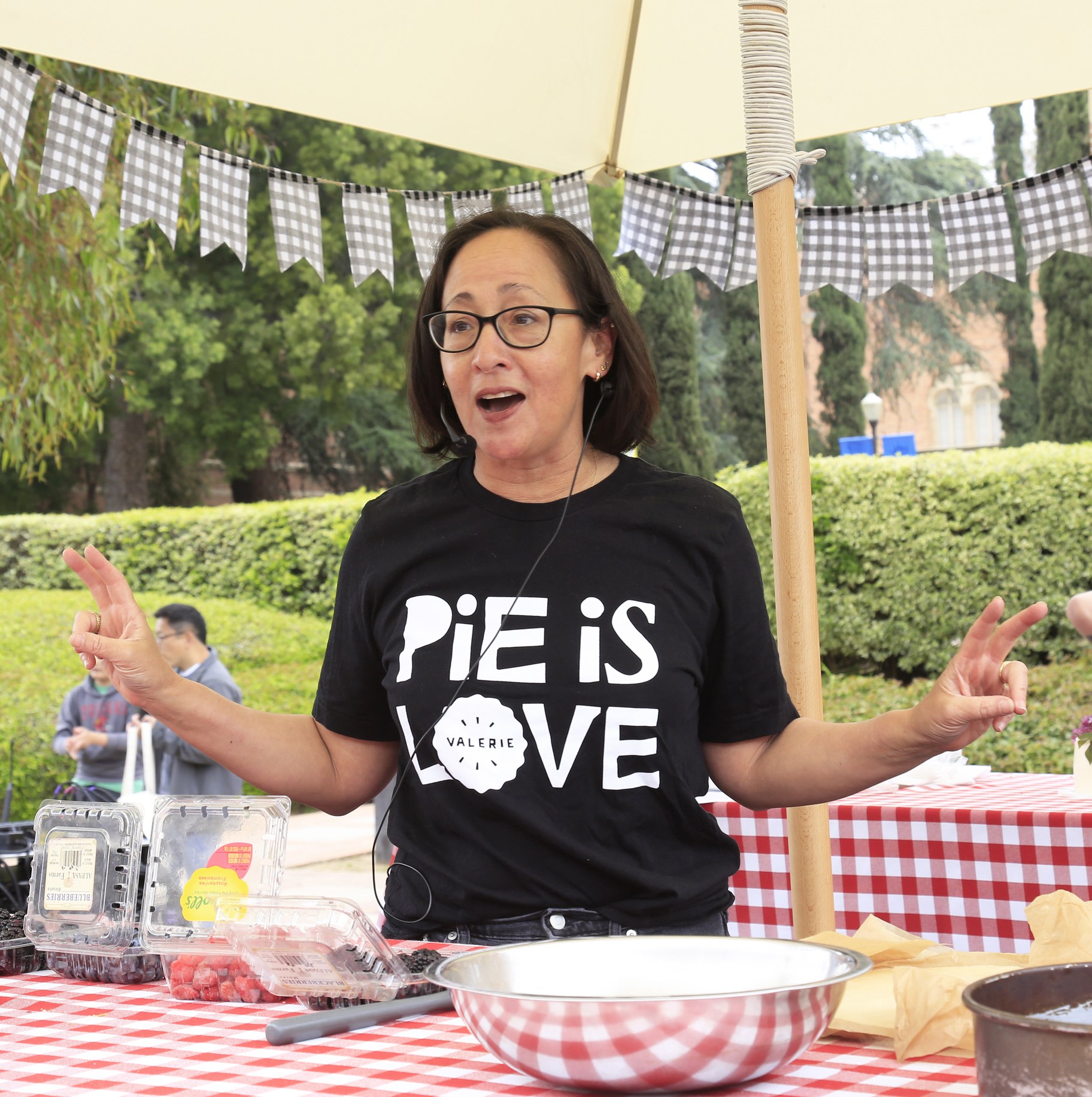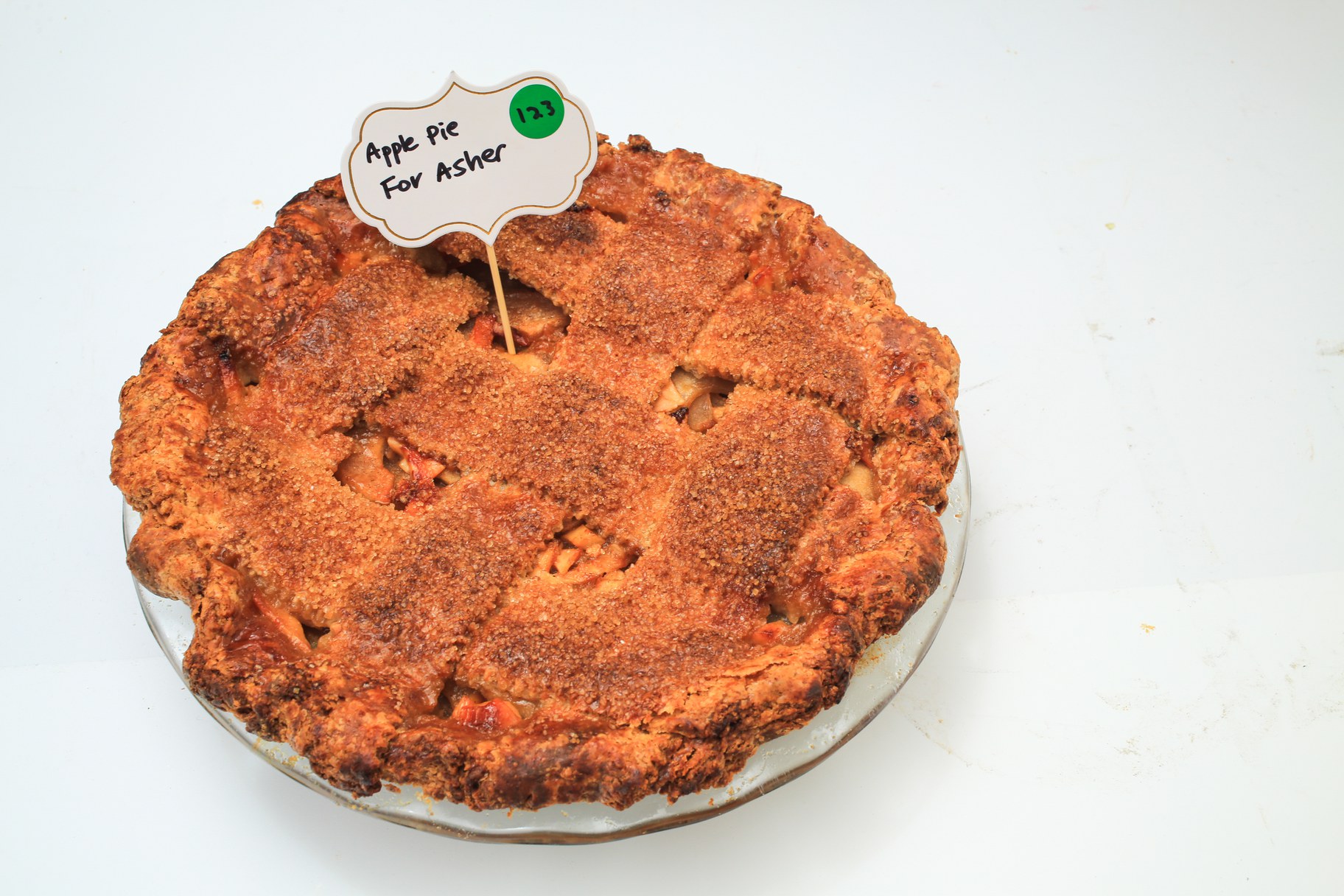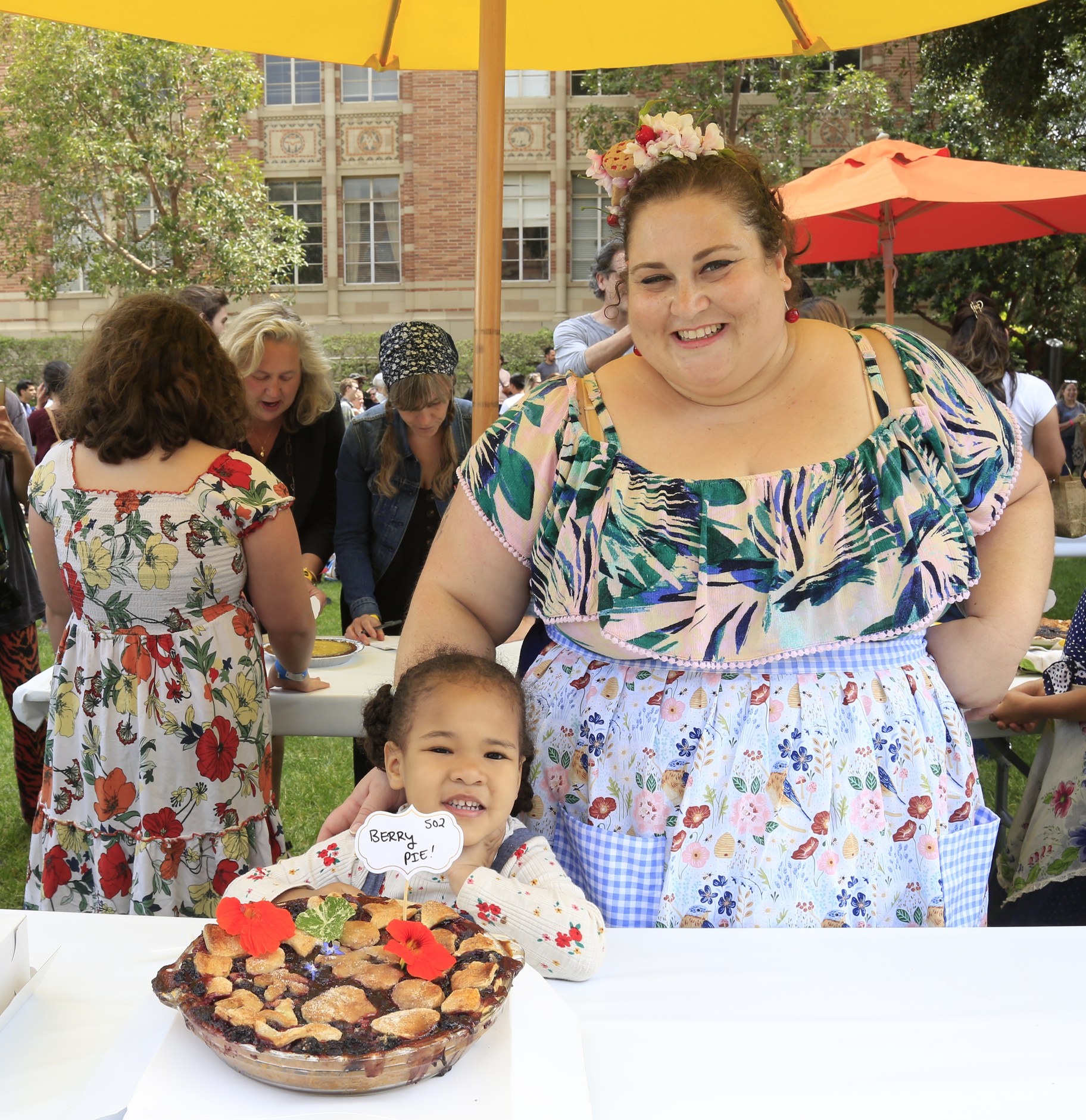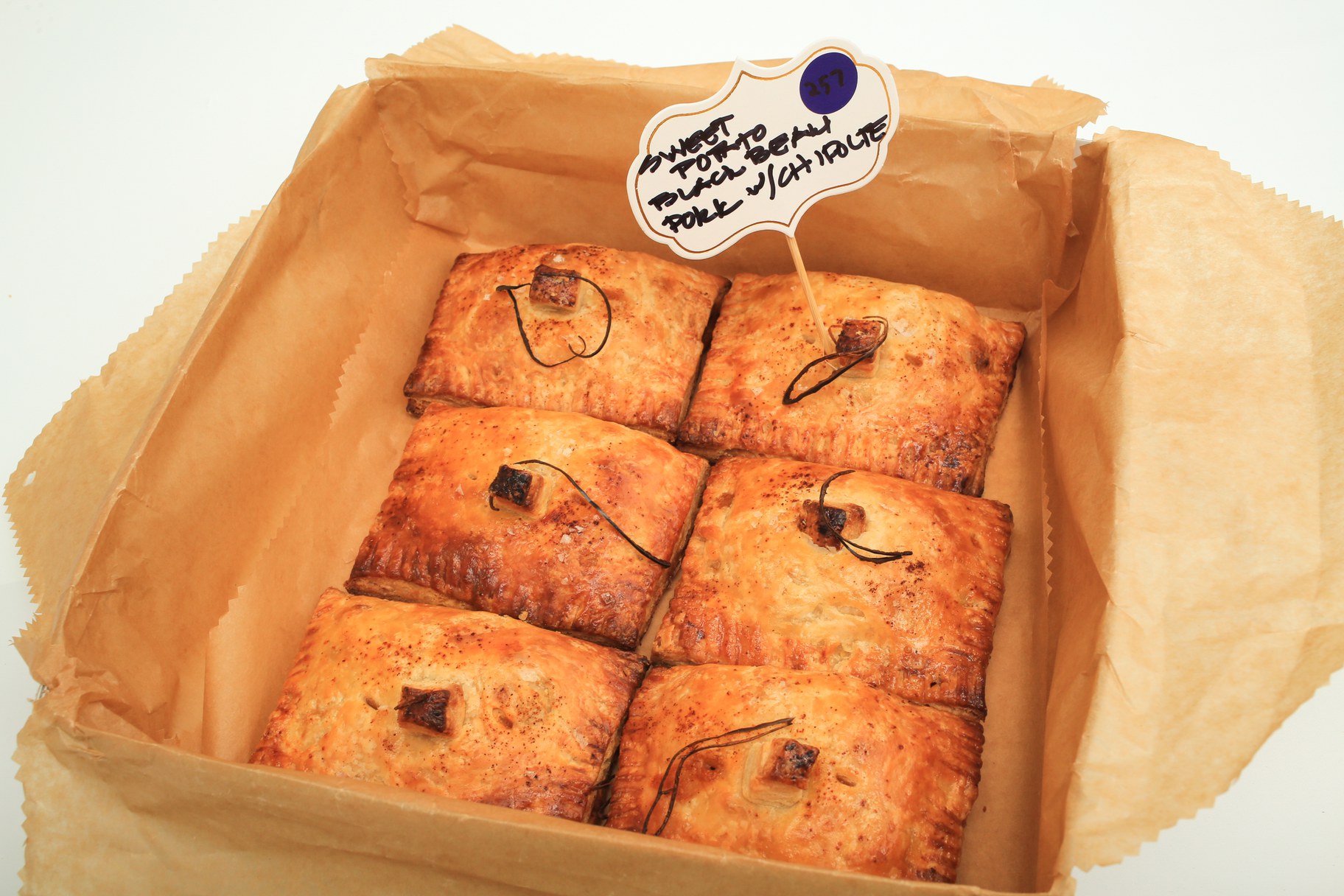The ovens have cooled. The pies have been eaten. The crumbs have been swept up. It's time to take stock of Good Food's 2023 PieFest & Contest. Approximately 500 pies competed, and our armada of judges chose the top three in each of the nine categories.
So how do you bake the perfect pie? We asked one of our longest-serving judges, Valerie Gordon, the owner of Valerie Confections, which is headquartered in Glendale and has a shop in Echo Park. She has lost count of how many times she has judged KCRW's pie fest, but she thinks it's around 10. So she's a pro.
 Valerie Gordon leads a demo at the 2023 PieFest & Contest. She was also one of the judges. Photo by Larry Hirshowitz
Valerie Gordon leads a demo at the 2023 PieFest & Contest. She was also one of the judges. Photo by Larry Hirshowitz
"I felt energetically it was the best [pie contest] ever," Gordon says. "I think that people were more excited than I've ever seen. They were more committed to the contest than I've ever seen. There were more people coming to observe and participate in the festivities. There was the best vibe. It was really, really joyous."
This year, Gordon helped judge the Savory pies and the Apple pies, always a fiercely contested category that's swamped with entries. And she has three tips for bakers who want to up their pie game and improve their chances of landing in the winners' circle at next year's PieFest.

This apple pie doesn't look like it has any issues with being underbaked. Photo by Ian Kose
1. Don’t underbake your pie
If you don't have color in your crust, it's underbaked. If you see any translucence in your crust, it's underbaked. If your crust is soft, it's underbaked. As Sherry Yard said when she was announcing the winners, "Your crust should not be the color of my hair," referring to her white-blond pigtails.
"There were many, many pies where there were soft pie crusts and translucent, underbaked soft bottoms. When you get a rise on the crust and you also get a nice dark golden tan on the crust, that's a sign that it is well baked and it will have great flavor and great texture," Gordon says.
Gordon also revealed that fellow judge Yard often takes the pie that is being evaluated out [of its dish] to see the bottom of the crust. So you want to make sure the bottom of your pie crust has a dark golden color and is crisp and sturdy.
How do you achieve that? You bake your pie longer. Even if a recipe says "Bake time: one hour," don't just blindly follow that instruction. Take your pie out of the oven and look at the color of the crust. Besides, every oven is different and most don't accurately read their own temperature. Gordon recommends that you get an oven thermometer to hang inside your oven so you can better gauge the temperature. But even then, "Don't just go by time, go by visual cues for your pie," she says.

One of the contestants in the Kids category shows off her berry pie, which can be tricky to make because you have to control the amount of liquid. Photo by Larry Hirshowitz
2. Beware too much liquid
"There was a lot of extra liquid in a lot of the apple pies, the berry pies and the savory pies," Gordon says. You'll want to consider how much liquid the ingredients in your filling are putting out. Have you added enough stabilizer? Should you par-cook some of the fruit? Are you using really watery fruit? If so, perhaps you should consider different fruit.
"If you have something like an apple pie, I would suggest that people par-bake their apples before they build the pie. Don't go with raw apples because then you'll have this whole puddle situation. And with berries, it's good to really think about what happens to these fruits when they bake. Any berry with a lot of pectins — so blueberries, raspberries, blackberries — those hold up really nicely. You don't have to necessarily par-bake those or par-cook those fruits. Whereas something like a strawberry could have a lot of water, particularly if it's early in the season or if they're larger," Gordon says.
She also reminds contestants that your pie will be sitting out for several hours. So when you're practicing, bake your pie and let it hang out on your counter for six hours to see what happens. How does it look? How much liquid does it release? How does it hold up?
"Look at what happens with these pies," Gordon says. "You're baking them at home, you're transporting them and then they're sitting out for an extended time at the pie contest. So it's important to think about what are the conditions that a pie will live under during the judging."

This sweet potato, black bean, pork and chipotle pie was a contender into the Savory category. Photo by Ian Kose
3. Don’t be afraid of seasoning
Gordon says that in many of the savory pies, and in some of the sweet ones too, there was under-seasoning and a lack of complexity and flavor.
"With the savory pies in particular, you want to make sure that the filling tastes really good. If I were doing a savory pie, I would put a little bit of the crust on a baking sheet, bake it until it's a nice, golden brown, take that off, cook up my filling, put it on the crust and taste it together," she says.
You can amp up the flavor with fresh herbs and more salt. "I was on Team Savory and there were several savory pies where the judges were like, 'It really needs salt.' That was the mantra I kept hearing from the savory judges," she says.
"If you've got a slice of savory pie, that should be a meal. And when you're tasting it, you want to have complexity and flavor. You want to have a little bit of acid, a little bit of heat, some richness to it."
Here's something Gordon won't tell you, because she doesn't know… but if you want the best odds of winning a ribbon, consider entering a pie in the Nut category. It had the least amount of entries this year so you'd have the best odds.

Judges (left to right) Karen Tongson, Lien Ta, Valerie Gordon and Mona Holmes wait to announce the winners at the 2023 PieFest & Contest. Photo by Larry Hirshowitz

